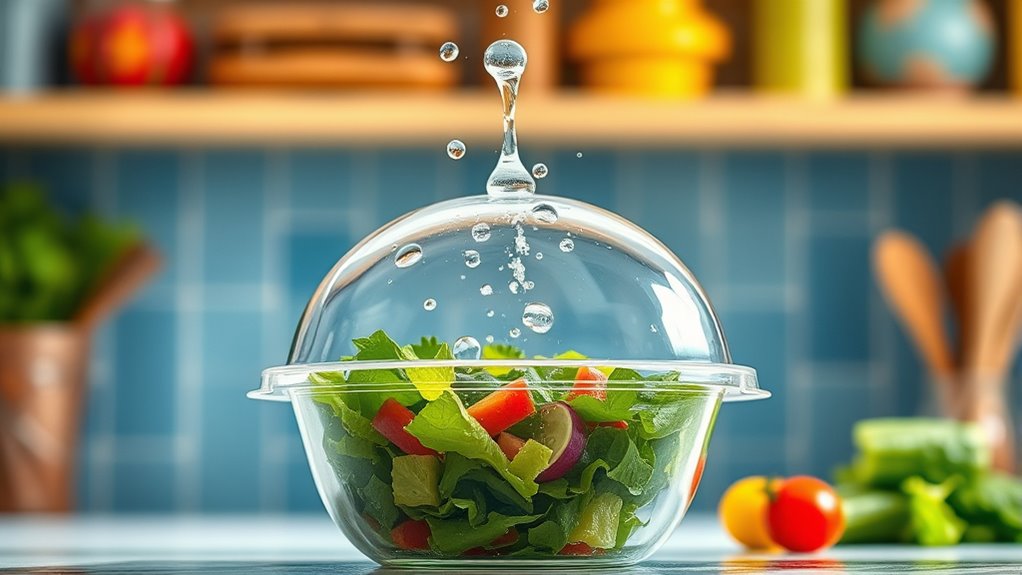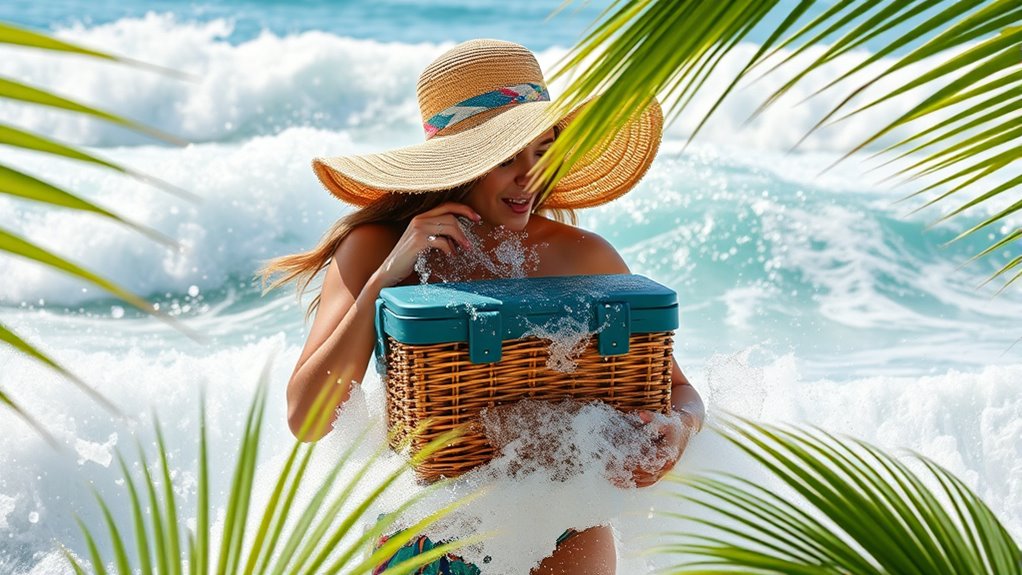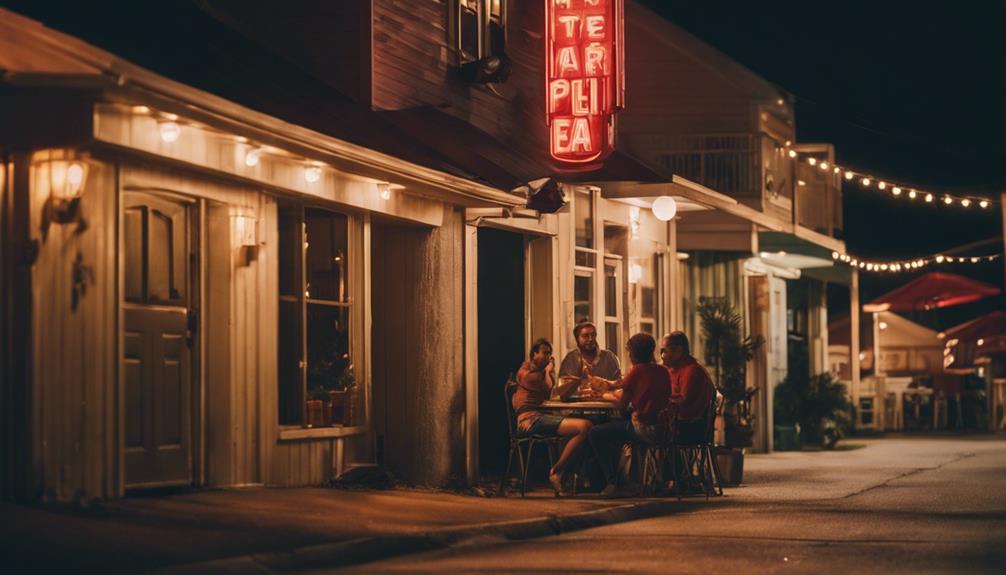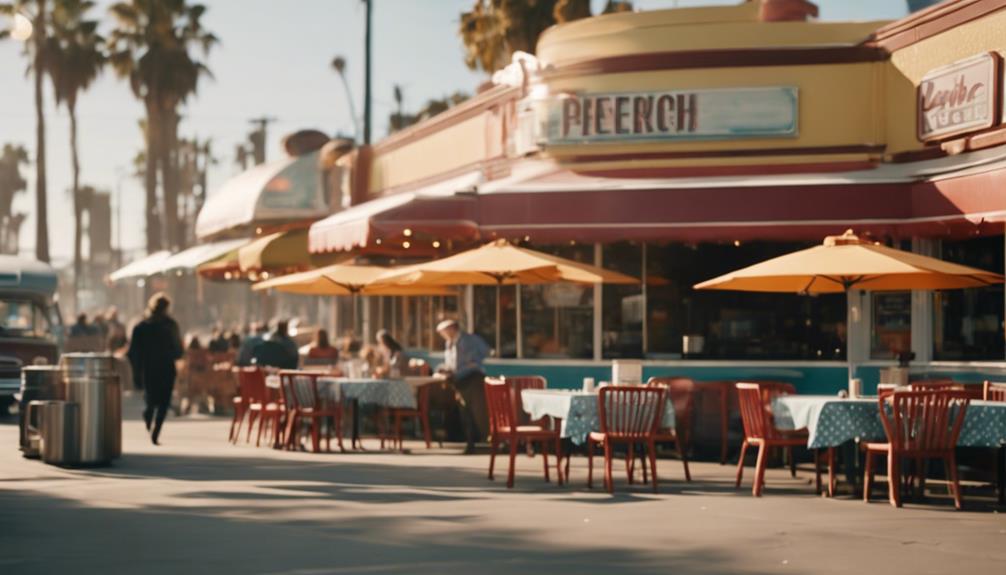To safeguard your food from waves and splashes, start by storing it in waterproof containers with tight seals to prevent water from seeping in during transport. Use splash guards around sinks and cooking areas to deflect water spray and keep your workspace dry. Regularly check and clean these protective tools to guarantee they work properly. By combining waterproof storage and splash barriers, you can keep your food safe in splash-prone environments—learn more about effective techniques ahead.
Key Takeaways
- Use waterproof containers with secure, leak-proof lids to keep food dry during splashes or wave exposure.
- Place splash guards around sinks and cooking areas to deflect water away from food surfaces.
- Store food in sealed waterproof containers when near water sources or during outdoor water-based activities.
- Regularly inspect and clean containers and splash guards to maintain their water-resistant effectiveness.
- Position water barriers strategically to shield food from direct waves or splashes in water-prone environments.

When waves and splashes threaten your food, taking proactive steps can make all the difference. Whether you’re enjoying a picnic by the water or cooking near a busy sink, water can quickly ruin your meal. To keep your food safe, start by investing in waterproof containers. These containers are designed to seal tightly, preventing any water from seeping in and protecting your food from unexpected splashes. Opt for containers made with durable, leak-proof materials so you can carry your meals confidently without worry. When choosing waterproof containers, look for ones with secure lids that snap on firmly, providing an extra layer of protection against water intrusion. Keep in mind that these containers are versatile and can be used for both storage and transport, making them an essential part of your food protection toolkit.
In addition to waterproof containers, splash guards serve as an excellent physical barrier against splashing water. Splash guards are typically placed around sinks or cooking areas to deflect water away from your food. When you’re washing dishes or preparing food near a water source, installing a splash guard can help contain water splashes within a designated area. This simple device reduces the risk of water reaching your food or utensils, especially in busy kitchen environments or outdoor settings where splashes are unpredictable. You can find splash guards in various sizes and styles, so choose one that fits your space and needs. Easy to install and clean, splash guards are cost-effective solutions that considerably lower the chance of water damage. Incorporating waterproofing techniques into your food protection plan can further enhance your safety measures.
Combining waterproof containers with splash guards provides a detailed approach to protecting your food from water hazards. Use waterproof containers to store and transport your food securely, especially in environments prone to splashes. Meanwhile, splash guards act as a first line of defense when you’re actively working near water sources. Positioning these guards strategically around sinks or cooking stations helps contain water, keeping your workspace dry and your food safe. Remember, the key is to anticipate water exposure and act proactively. Regularly check the seals on your containers and keep your splash guards clean and in good condition to ensure they function effectively. By taking these simple but effective steps, you’ll minimize the risk of water ruining your meals, leaving you free to enjoy your time without worry. Protecting your food from waves and splashes isn’t complicated—just a matter of using the right tools and staying prepared.
Frequently Asked Questions
Can Waterproof Containers Prevent All Types of Splashes?
Waterproof containers like sealed containers and waterproof ziplocks can prevent most splashes, but they might not block all types of water exposure. If a splash is strong or prolonged, some moisture could seep in, especially around seals that aren’t perfectly tight. To guarantee your food stays dry, use high-quality sealed containers and double-check the seals. Remember, no container offers 100% protection, so handle with care in wet environments.
What Materials Are Best for Splash-Resistant Food Storage?
For splash-resistant food storage, you should use materials like high-quality plastics, glass with silicone seals, or stainless steel. These materials enhance food preservation by preventing moisture and splashes from contaminating your food. They also offer superior container durability, ensuring your storage solutions last longer and keep contents safe. Choose containers with tight-fitting lids to maximize splash resistance and maintain peak freshness, especially in environments prone to waves or splashes.
How Do I Handle Food in High-Humidity Environments?
Did you know high humidity can increase food spoilage by up to 30%? To handle this, you should focus on humidity control and moisture barriers. Use airtight containers to keep moisture out, and consider dehumidifiers in your storage area. Proper sealing prevents mold and bacteria growth, keeping your food fresh longer. Stay vigilant with humidity levels, and your food stays safe and delicious even in the most humid environments.
Are There Portable Solutions for Protecting Food Outdoors?
Yes, you can protect your food outdoors with portable solutions like food tents and shelters. These provide a quick, effective barrier against waves, splashes, and environmental elements. Simply set up a sturdy food tent over your dishes or use a portable shelter for larger groups. They’re lightweight, easy to carry, and designed to keep your food dry and clean, ensuring your outdoor meal stays fresh and protected.
Can Protective Covers Be Reused After Exposure to Waves?
Yes, protective covers can be reused after exposure to waves, but you should consider reusability concerns and material durability. If the cover is made from sturdy, waterproof materials like heavy-duty plastic or laminated fabric, it’s likely reusable. However, if it shows signs of tearing, warping, or damage from saltwater or debris, it’s better to replace it. Always inspect the cover thoroughly to verify it maintains its protective qualities before reuse.
Conclusion
Now that you’ve learned how to shield your food from unwanted waves and splashes, you can enjoy your meals with a little more peace of mind. Think of these precautions as gentle gestures that keep your food safe and fresh, allowing you to savor every bite without worry. With these simple tips, you’re creating a cozy, protected space for your culinary delights—turning everyday moments into delightful experiences. So, go ahead, indulge in your favorite dishes with confidence!









